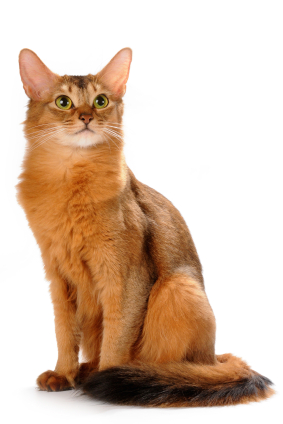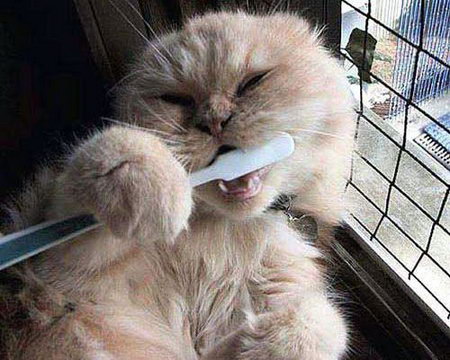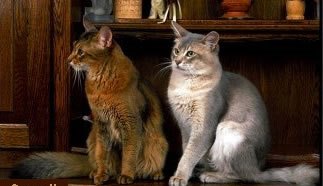Basics:

Somali cat ruddy color sitting isolated on white bakcground
Genesis:
from the short-haired Abyssinian which carried the long hair gene.
Weight: 2 ½ – 5 kg .
Character: Friendly, active, intelligent , but also prone to moods at home and will certainly get the attention and approval of their owner . They like to go beyond what both mentally and physically they need space
Origin:
The mother-of longhaired Somali, the short-haired Abyssinian, bred over a hundred years. Began as a race in England this will soon spread throughout Europe and America. The origin of the Abyssinian was a mix of ticked tabby cats, often unclear and several oriental origins, mixed with house cats in the beginning and later. This fact is indirectly responsible for it was born in the sixties of the last century in particular combinations in England but elsewhere longhaired kittens.
The recognition of these “long-haired Abyssinian”, which is essentially the somali, was not easy. Some breeders were ashamed of the long hairs in their litters and were worried that it would come out that their animals the recessive long-hair factor which contributed still not part of the Abyssinian. Others thought that there was possibly tampered with pedigrees and boosted the resulting long hair. As it turned out the origin of the gene for long hair was simply to track very early. Genealogical research revealed that, in the thirties of the twentieth century, but after the Second World War in England there are some long-haired domestic cats and also a Persian “crept” were and when distant descendants of these animals were later crossed with each other, came out the property for long hair again.
Character:
As the Abyssinian, the Somali never become a real modekat. The appearance and character appeals to a small audience that falls on the combination of an elegant look and an active character. Most people who breed somali have only a small group home. This is because the breed requires quite a lot of attention and does not feel at ease in a large group. Somalis are intelligent animals who want to be involved in everything that happens in the house. They are very focused on people and want a close relationship with their owner. They are not real lap cats, but where you are or what you’re doing is also present your Somalis to interfere against them there!
That means an owner who has an opportunity and who appreciates a band. A Somali sees his owners as “buddies” where you take along things together. They are picky sensitive animals who feel out of place in a large group, but also not to be able to live like any pet in a house where the owners work all day. The Somali is an active affectionate and sometimes demanding cat for people who appreciate the combination of subtlety, sensitivity, activity, affection and intelligence.
Appearance:
The image of the Somali is a colorful cat with a distinctly characteristic ticked tabby pattern. The cat is medium in size. The Somali is elegant but muscular construction and exhibits an active and alert appearance. The head is a moderate slightly rounded wedge shape with rounded contours. The line is sloping nose and between the ears is a lot of space. The head is about in an elegant neck. The muzzle is neither pointed nor square. The chin should be firm with a comprehensive set of teeth. The ears are alert, large and moderately pointed and open. The eyes are almond formation, large and bright and expressievol. They can be golden to green. The eyes are rimmed by fine dark line, encircled by a lighter colored area. The body is medium in length, elegant and stylish, well muscled and strong without being coarse.
Somali’s physique is between the two extremes of stocky and extremely elegant in. The entire body should have a harmonious balance. The legs are elegant and delicate. The feet are small, oval and compact. The Abyssinian gives the impression to be high on the legs. The tail is firmly attached to the feed rate, on average of length and by the long hair is bushy and the tail ends in a broad plume.
Coat and pattern:
The coat is soft, silky feel and medium length and silky in texture. He gives them over when petted and shine. The average length is varying over the body, which is shorter on the shoulder blades, but with a nice developed collar and a “trousers” and also between the toes have long hair. Each has its distinctive tickingbandjes at the end – preferably more than 3 per hair.
The “Ticking” should be evenly distributed over the body. The dark tickingbandjes on the ends contrast with the lighter colored areas on its base. Undercoat the color should be bright and solid to the core. A deep warm foreground color (in the silver shining silvery) is preferred, but should not be at the expense of the ticking. Some darker shading is allowed on the backline. Color Errors are a white medallion net, streaking on the legs closed collar around the neck rings or rings on the tail, a cold color or gray ondervacht.De somali is bred in different colors. The basic ground color is always found at the ends (the getickte pattern), undercoat has a lighter shade. The silver varieties possess the basic color but lying on a silvery white undercoat.
Maintenance:
 The somali requires relatively little daily maintenance. The coat has such structuur that this hardly burdock . A brushing occasionally with a soft brush to remove dead hair is sufficient. The semi- long hair coat tangle little, but watch burdock spots in groin and as the cat in winter in full coat is also in the ” trousers ” on the hind legs . In verharingsperioden may need a little more grooming to prevent the cat swallows too much loose hair .
The somali requires relatively little daily maintenance. The coat has such structuur that this hardly burdock . A brushing occasionally with a soft brush to remove dead hair is sufficient. The semi- long hair coat tangle little, but watch burdock spots in groin and as the cat in winter in full coat is also in the ” trousers ” on the hind legs . In verharingsperioden may need a little more grooming to prevent the cat swallows too much loose hair .
Please also regularly on the teeth – some Somali ’s have a tendency to tartar formation and gum problems and here is timely prevention and teeth properly cleaned by the vet during the annual inspection essential
.
Colors:
Ruddy The wildtype is the best known and one of the most common coat colors in the Somali. The ticking is black and the foreground color warm apricot together these colors give a warm glow.
Sorrel (“Cinnamon) The color is basically the color that is called by other cats cinnamon. The ticking has a warm cinnamon color (cinnamon in English cinnamon) and the ground color is warm apricot.
Chocolate Chocolate colored and the ticking ground color dark apricot. The coat makes a whole a deep warm brown impression, which is softer than the wild type.
Blue Blue color variety blue is a dilution of black (ruddy) and is characterized by a steel-blue ticking with an oatmeal-colored ground color which together optically soft blue-gray tint.
Fawn Fawn is the dilution of cinnamon. The ticking is sand colored and the ground color is light beige. Together gives a picture of a warm sandy-colored cat.
Silver All colors can occur with a silvery white undercoat. The base color is silver with apricot-colored or sandy, but preferably sparkling white. This is the tickingpatroon distinctly forward.
Other colors There are breeders who focus on the development of new colors, including red, cream and tortoiseshell (tortie), whether or not with a silver undercoat.


Health:
Most Somalis are healthy, strong animals. The breed is an average of 12 to 15 years old. Because there may be some genetic problems, it is recommended only deserve to buy a kitten from a serious enthusiast breeders that are breeding has examined preventive accordingly. This is among other things progressive retinal atrophy (PRA) (a genetic disorder that eventually leads to blindness), amyloidosis (a term lethal protein deposits on vital organs), a pyruvate kinase deficiency (PKDef) which can be tested by DNA and patellar luxation (PL) (loose kneecaps). A serious breeder sells just kittens parents that a oogspiegeltest (to exclude sufferer shelf) undergo PRA, which are tested parents PKDef who checked the knees by the veterinarian and using pedigree screening lines with an increased risk amyloidosis exclude the pedigree for breeding. Of course you can buy the best familiar kitten kitten through the mediation of one of the breed clubs.
Check out the broadcast Cats101 about this breed
